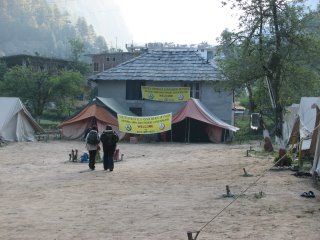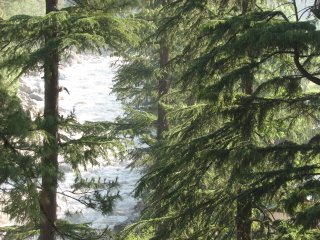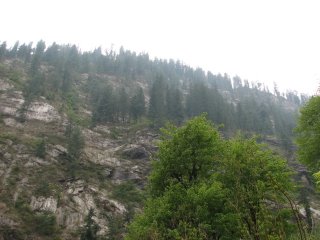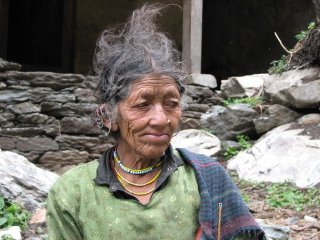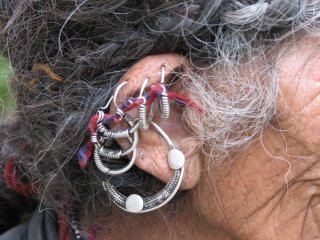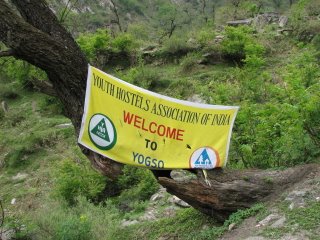The myth of Malana
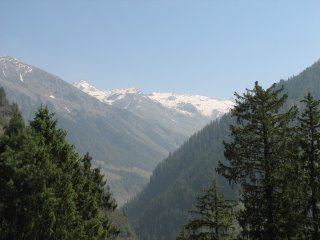
5th day: 15th May 2006 : Yogso to Behali
The group was up and about at 5 a.m. Even the die hard late-risers like Soumya are up and about – mainly to use the open air before the crowd builds up for the ‘morning activities’. What ever may be the inspiration, it made the task of the group leader easy to get the group ready on time. 6 a.m.. was the tea and by 7 a.m. everyone was ready for the breakfast. There was a slight delay for Breakfast which got ready by 7.30 a.m. We had to further wait till 8.30 a.m. as the cooks got busy making packed lunch for the group. This system of giving packed lunch was putting a lot of stress on the cooks and at the same time delaying the departure of the group for the trek.
The myth of Malana
The camp leader briefed the group about the trek ahead. He warned bout entering the Malana village which is stated to be a separate Republic within India.
i) We were told that they do not accept the rule of India and are from a separate stock. It is said that they belong to the Greece and had come with Alexander. After the death of Alexander, they moved over here and since then, have been maintaining their own cultural identity separate. They consider themselves superior and therefore would not tolerate any contact with the outsiders. They do not bathe and would not marry people from outside.
ii) People of Malana have their own government, parliament, police and system of justice. They do not go to courts in India. They do not vote in Indian elections and have the oldest democracy in the country.
iii) No one should touch a Malana person nor go anywhere near the temple, failing which there would be a fine of Rs, 1,000 for which YHAI is not responsible.
iv) He warned us not to take any photographs of Malana people without their consent. We were told not to stop anywhere in the village and walk past the village in total silence. The effort was to scare trekkers about getting close to the Malana people. Most of us were intrigued why this is so.
Since Malana was only about 2 km ahead, we decided to check out these facts ourselves. Malana was perched right on top of Yogso camp.
We finally started at 9 a.m. The trek up to Malana was through a steep climb of 2 km, which the group accomplished by 10 a.m.
The guide for the day was Mr. Budhi Singh who was very tense and angry all the time. Though he was from Malana, he was very antagonistic with the group and refused to talk, despite persistent questions from the group members about Malana. As we reached the outskirts of Malana, Budhi Singh stopped us at a open place and repeated all the threats about the village. He repeated that everyone will file past the village in single column without any noise. we had no choice. We obeyed. We saw the first hint of snow capped mountains since the trek started. We could see the Malana hydro project from where we started our trek the day before.
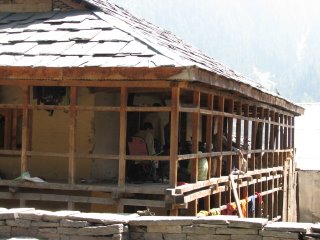
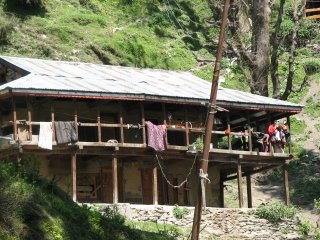
As we approached Malana, we found that this village is very prosperous with all pucca houses, which is a rarity in the hills. The houses were made of fine quality wood and had abundant stock of teak logs under each house. The houses were decorated with multifarious colors. As we were staring at the prosperity of the houses, we heard the children shrieking ‘thoffee..thofee’. it took us a while to understand that they are asking for toffees. We fished out the toffees that we packed for the trek and gave them. That led to flood of kids who came from all the houses in the village and asking for toffees. We ran out of toffees and had to buy more at the village shop and freely distributed. We liked the glint in the eyes of the children as they celebrated the receipt of unexpected gift from total strangers – people whom they are supposed to shun.
The kids were freely moving with us, talking to us, there is a school, a shop and the village seemed like any other Indian village – though extremely prosperous. The village has electricity, luxury that none of the other villages in the vicinity enjoyed. It has a government school, which has a teacher (another luxury? ). The medium of instruction is Hindi. When we asked the kids what they want to become after they grow up, they said, ‘teacher’.
The first myth that ‘people of Malana want to keep away from the others’ – is falling apart. We marched with hundreds of kids walking along with us – like heroes being welcomed into the village square. The village square was an astounding sight with old, very, very old temples adorning a clean central place where lots of men were idling around. The temples stole the show.
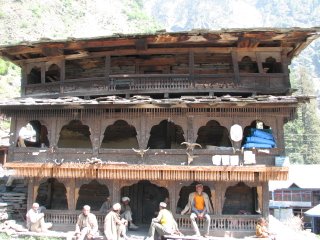 There is no doubt that the temples were ancient and the architecture had a distinct style of their own. The wooded structure was adorned with intricate work done by hand. Three was buffalo horns to ward off the evil spirits. The temple is the temple of Jamadagni Rishi (sage) who did sever penance in this very area. The temple follows Vedic traditions introduced by Jamadagni as against the atavistic religious practices of the nearby villages. At once, the difference became apparent. The village has been kept apart from the rest of the villages to ensure continuation of the Vedic traditions that were introduced by Jamadagni.
There is no doubt that the temples were ancient and the architecture had a distinct style of their own. The wooded structure was adorned with intricate work done by hand. Three was buffalo horns to ward off the evil spirits. The temple is the temple of Jamadagni Rishi (sage) who did sever penance in this very area. The temple follows Vedic traditions introduced by Jamadagni as against the atavistic religious practices of the nearby villages. At once, the difference became apparent. The village has been kept apart from the rest of the villages to ensure continuation of the Vedic traditions that were introduced by Jamadagni.The main temple of Jamadagni sage at Malana
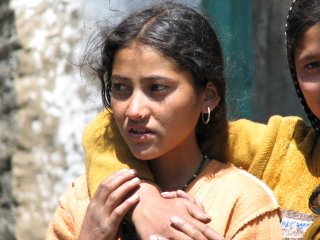 T
T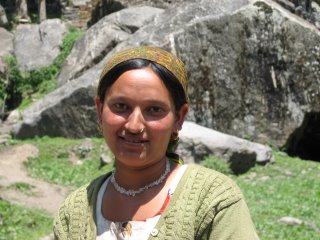 he people represented the best of the himachali features. We saw some of the stunningly charming girls in the village. We took their photographs and they obliged without hesitation. Neema wanted that her photograph be sent to her by post and refused to accept a toffee. She wanted a chocolate instead. We fished out one for her. Anything for a smart young woman like her!
he people represented the best of the himachali features. We saw some of the stunningly charming girls in the village. We took their photographs and they obliged without hesitation. Neema wanted that her photograph be sent to her by post and refused to accept a toffee. She wanted a chocolate instead. We fished out one for her. Anything for a smart young woman like her!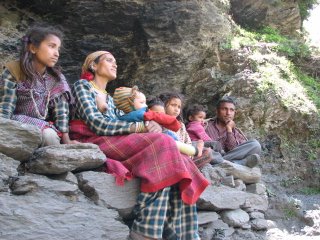
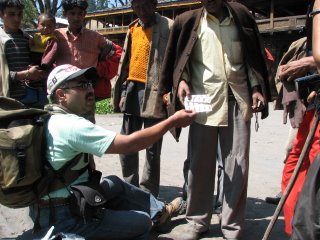 As we stared at the temple of Jamadagni, a crowd started gathering – of curious men most of them wanted to know if we have any medicines. We saw many people suffering from fevers and diseases of eye. We met the village store keeper and his son – a reasonably educated young man. As we were chatting with them, about the history of the village – they knew precious little, we heard a commanding voice from behind. Everyone kept quiet and there merged a diminutive old man, with a large turban on the head and with a very, very prominent nose. There was no doubt who was the boss of the village – it was Budhi Ram, the village headman.
As we stared at the temple of Jamadagni, a crowd started gathering – of curious men most of them wanted to know if we have any medicines. We saw many people suffering from fevers and diseases of eye. We met the village store keeper and his son – a reasonably educated young man. As we were chatting with them, about the history of the village – they knew precious little, we heard a commanding voice from behind. Everyone kept quiet and there merged a diminutive old man, with a large turban on the head and with a very, very prominent nose. There was no doubt who was the boss of the village – it was Budhi Ram, the village headman.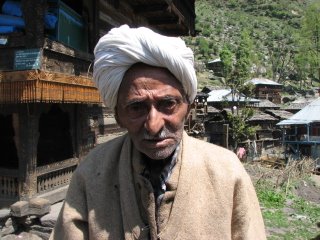 Aged 103 years, Budhi Ram was very fit and had all the wisdom that the world can offer. He asked us if we have any medicines for his eye which has been watering profusely. We tried to see if we can help him out, but found that we had no medicines for the eye problem. I suppose the glare of sun on the hills would have taken their toll over a long period. We advised that he should come down to Kullu so that we can get his eye checked up for glaucoma. He smiled and said, ‘yes I will’. But there was no doubt that it is a clear ‘no’. We continued our discussion about the village with him. He denied any links with Alexander, but stated that the village separate due to the presence of Jamadagni in the village many hundred years ago. The sage has converted the locals to his way of life. Vedic traditions and pujas were introduced in a hill tribe which knew only the worship of nature. In order to keep the cultural identity separate, he imposed certain restrictions on the villagers meeting outsiders. Hence no marriages with outsiders, separate language, separate traditions - all to distinguish them from the hills tribes of Himachal. But he stock is the same as the himachalis and are no different. As we were conversing with Budhi Ram, the time flew by. Our guide was getting more and more agitated. He sent people to fetch us immediately. We had to leave.
Aged 103 years, Budhi Ram was very fit and had all the wisdom that the world can offer. He asked us if we have any medicines for his eye which has been watering profusely. We tried to see if we can help him out, but found that we had no medicines for the eye problem. I suppose the glare of sun on the hills would have taken their toll over a long period. We advised that he should come down to Kullu so that we can get his eye checked up for glaucoma. He smiled and said, ‘yes I will’. But there was no doubt that it is a clear ‘no’. We continued our discussion about the village with him. He denied any links with Alexander, but stated that the village separate due to the presence of Jamadagni in the village many hundred years ago. The sage has converted the locals to his way of life. Vedic traditions and pujas were introduced in a hill tribe which knew only the worship of nature. In order to keep the cultural identity separate, he imposed certain restrictions on the villagers meeting outsiders. Hence no marriages with outsiders, separate language, separate traditions - all to distinguish them from the hills tribes of Himachal. But he stock is the same as the himachalis and are no different. As we were conversing with Budhi Ram, the time flew by. Our guide was getting more and more agitated. He sent people to fetch us immediately. We had to leave.But as we were about to leave, we found something very strange. The village has a good guest house – constructed with good quality tiles and running water! It has electricity and telephone!!. We could not resist asking who would stay there. After some hesitation came the answer – the foreigners! That took us on a different trip. Why are the foreigners, that too Israelis, flocking to Malana? After persistent questioning, we gathered that they come for the best quality Charas (Cannabis Sativa) that is grown here. The cost of the charas of Malana referred to as ‘cream’ can go up to $ 50 per 10 grams, when sold outside. So the Israelis, mostly the soldiers on leave, come over to Malana and spend considerable time there. Instantly we found answers to several questions that dogged us. That explains the prosperity of the village, their desire to keep aloof (from the enforcement machinery?) and their exclusion from other social processes with the villagers around.
